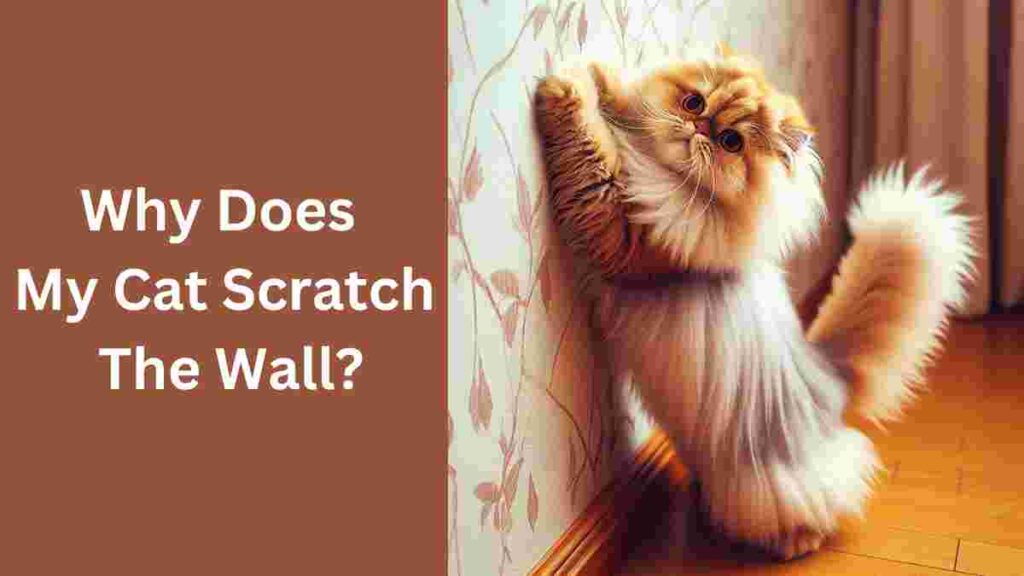Why Does My Cat Scratch The Wall: There’s something about the signature sound of your cat’s claws meeting the stuccoed wall that sets your teeth on edge.
It’s an everyday reprise — part of the rhythm of your home life — that signals to every creature within earshot, “Yes, I am here and this is mine.” To many of us, it’s puzzling and a touch exasperating. But to your cat, it’s a complex expression of their feline essence.
In this comprehensive guide, we’re going to explore the profound reasons behind your cat’s wall-scratching tendencies, and how you, as a cat owner, can foster an environment that satisfies their intrinsic needs without redecorating your home in the process.
Let’s unveil the mystery, “Why Does My Cat Scratch The Wall?”

Table of Contents
Setting the Scene: Why Does My Cat Scratch The Wall?
Take a moment to observe the reason for the scrape and hear the tale of an animal whisker-deep in its role as both wild predator and domestic companion.
The scratch is a precise and often rhythmic act, with forelimbs extended to their full potential. It’s not just about leaving claw marks for history’s sake; it’s a purposeful movement laden with multiple layers of meaning.
Let’s find the answer to the question, “Why Does My Cat Scratch The Wall?”
The Purpose of Scratching: Unraveling the Mystery
Scratching may seem solitary, but it’s deeply rooted in your cat’s sociability. It’s a bridge between their personas of predator and pet, an act that reinforces territorial claims, refines their hunting tools, and communicates myriad messages to the world.
The Natural Instinct of Scratching
Exploring the Wild Origins
The need to scratch is as old as the feline line itself, originating from the wild cat’s requirement to maintain sharp claws for survival. However, in the modern context, where the average housecat’s hunting is limited to batting at a feathery wand, the need for claw maintenance has shifted into a more symbolic and social function.
The Role of Scratching in Feline Communication
Scratching is a cat’s graffiti, telling the world, “I was here.” The scent glands in your cat’s paws leave behind a unique olfactory signature that is as distinctive as a fingerprint. This communication is vital in multi-cat households or in areas where outdoor encounters with other animals are possible.
Understanding the Physical Need: Exercise and Stretching
For your cat, a good scratch is not only about logistics and social currency; it’s also a form of exercise. The extension and retraction of the shoulder and back muscles provide a cat with a full-body stretch that’s beneficial for posture and flexibility.

Environmental Enrichment: Creating a Cat-Friendly Home
To steer your cat’s scratching enthusiasm in the right direction, the home environment must be designed with feline sensibilities in mind.
Providing Proper Scratching Surfaces
A home without a designated scratching post is like a library without books. It’s a fundamental fixture for your cat’s well-being.
Types of Scratching Posts and Pads
The variety of scratching posts on the market can be overwhelming, but a basic rule of thumb is to mimic the surfaces your cat naturally desires, such as sisal, carpet, and wood.
Placement Considerations
Where you put the scratching post is as crucial as what it’s made of. It should be tall enough for a full stretch, stable, and located in high-traffic areas or near their favorite resting spots.
Incorporating Vertical Space
Cats are born climbers, and the more opportunities they have to reach upwards, the happier they’ll be. Shelves, cat trees, and even window perches all help satisfy their instinct to climb and survey their domain.
Importance of Mental Stimulation: Toys and Puzzles
An enriched environment isn’t just about physical needs; mental stimulation is equally important. Puzzle toys and interactive play keep your cat entertained and help channel energy away from walls and furniture.
The Psychology of Scratching
Why do cats spend so much time and effort scratching when there’s so little to gain and so much that might get them in trouble?
Stress Relief and Emotional Well-being
Scratching is a dual-purpose behavior that also serves as a stress reliever. It’s an outlet for pent-up energy and frustration, especially for indoor cats.
Territory Marking and Ownership
When they scratch, cats not only leave a visual and olfactory marker but also physically claim an area as their own, which is important for their sense of security and stability.
Behavioral Problems: Separating Normal from Compulsive
Excessive scratching can be a sign of underlying problems, such as stress or health issues. It’s essential to monitor what is excessive for your cat’s baseline behavior and seek help if needed.
Top Notch Cat Food Available Here

Addressing Problematic Scratching
If your home is starting to resemble a giant scratching post, it’s time to take action. Understanding why your cat scratches will help you guide their instincts into pawsitive outlets.
Identifying Underlying Issues
Scratching can be a barometer of your cat’s well-being. If there’s a sudden change in their scratching habits, a visit to the vet is a good first step to rule out medical problems.
Behavioral Modification Techniques
Training a cat usually involves changing human behavior more than feline, but with patience and consistency, it is achievable.
Positive Reinforcement
Rewarding your cat for using the designated scratching area is the most effective method for training. Find out what motivates them, whether it’s treats, praise, or play.
Deterrents and Redirecting Strategies
Sometimes, the best strategy is a carrot and stick approach — use deterrents on off-limits areas while making the preferred scratching area more appealing.
Frequently Asked Questions (FAQs) – Why Does My Cat Scratch The Wall?
Why do cats scratch walls specifically?
Walls can be appealing for their texture and stability. If your cat is a wall-scratcher, it’s important to replicate these features in the appropriate scratching surfaces.
How can I prevent my cat from scratching furniture?
In addition to training, covering furniture with materials that cats dislike, like double-sided tape or aluminum foil, can deter them from scratching there.
Is declawing a solution to prevent scratching?
Declawing is a highly invasive and controversial procedure that should never be considered merely for the convenience of the owner. It can lead to long-term health and behavioral issues for cats.
Can scratching be a sign of illness in cats?
Yes, changes in scratching behavior can indicate an illness or discomfort, especially if your cat starts avoiding the use of their paws altogether.
My cat suddenly started scratching excessively. What could be the reason?
Any change in behavior warrants attention. Look for new stressors in their environment, or if the behavior is causing them pain, investigate medical causes.
What are some alternatives to traditional scratching posts?
Cats have varied tastes when it comes to scratching posts. Explore alternatives like horizontal scratching pads, cardboard boxes, and even logs for outdoor cats.
How can I train my kitten to use a scratching post?
Starting early is key. When your kitten goes in for a scratch at an unapproved location, gently place them at the scratching post and encourage them to use it.
Are there specific breeds more prone to excessive scratching?
While all cats have a scratching instinct, some breeds may be more enthusiastic about expressing it. Higher-energy breeds, like Siamese or Bengals, might require more robust outlets for their natural urges.
Is there a difference in scratching behavior between indoor and outdoor cats?
Outdoor cats have a greater array of surfaces to scratch on, which might impact their behavior compared to indoor-only cats. However, the need to scratch remains consistent.
Should I be concerned if my cat scratches only when I’m not home?
Cats are creatures of habit and often express themselves when no one’s watching. Regular enrichment and plenty of opportunity to engage with scratching posts can help address this issue.
Wrapping Up – Why Does My Cat Scratch The Wall?
Why Does My Cat Scratch The Wall: Understanding the motivations behind your cat’s scratching will help foster a deeper bond and create a living space that is harmonious for both you and your four-legged designer.
Remember, patience and thoughtful observation are the keys to modifying any behavior. By meeting your cat’s needs head-on, you’re not just preventing unwanted property damage — you’re enriching their life in ways that resonate with their deepest instincts. Ready to invest in more scratch posts and less wall stress? Your cat will thank you with the purr of satisfaction.
So, the answer to the question, “Why Does My Cat Scratch The Wall?” is given above and hope it served your purpose of visiting us.

Pingback: Is Fabuloso Safe for Cats? Understanding Household Dangers to Felines [3 Key Findings] - Pawfect Pet Tips